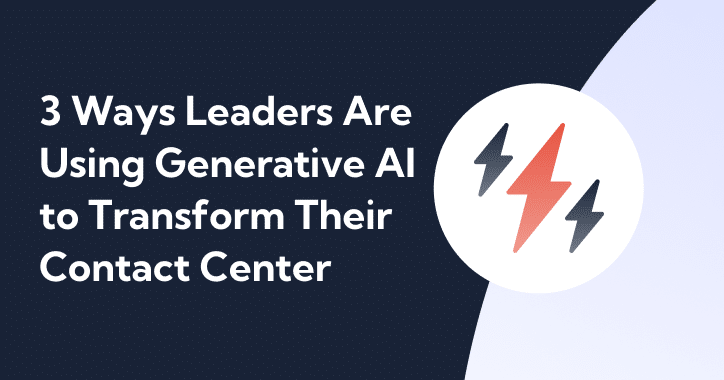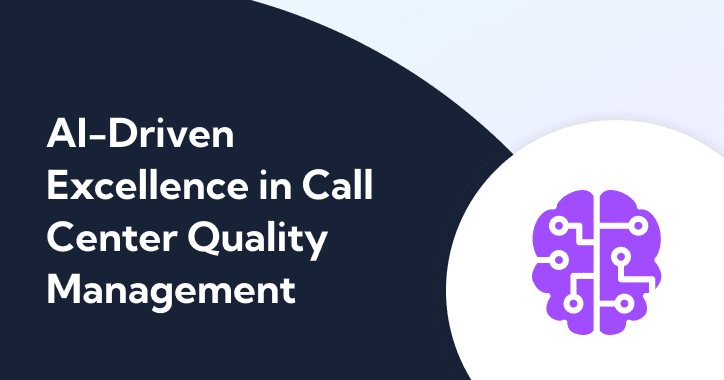Customer expectations have reached new heights, and businesses must adapt to meet their demands.
And if you’re still relying on a traditional contact center model with long wait times, scripted interactions, and frustrated customers, your business is destined to lose a lot of customers, and concurrently, money.
Conversational Artificial Intelligence (Conversational AI) aims to solve many of the difficulties that the modern contact center faces, such as capacity issues, long waiting times, and unresponsiveness during non-business hours, among other things.

This guide will help you understand what conversational AI is, how it works, and its benefits for contact centers, as well as the future of this technology and its challenges.
What is Conversational AI?
Conversational AI is a technology that users can have a conversation with, almost as if they were having a human conversation. Conversational AI tools are pre-trained with large volumes of data (thus the “artificial intelligence”) that qualify them to provide support for customers looking for assistance.
Exploring the Benefits of Conversational AI in Contact Centers
Some of the benefits of conversational AI in contact centers include:
Enhancing Customer Engagement and Satisfaction in Contact Center Operations
Today, customers’ service level expectations are much higher than anytime before. When a customer visits your company’s website or social media page, they expect an immediate and accurate response to whatever query they may have. However, if your resources are limited, that can be very challenging to achieve.
Conversational AI has provided a fast and cost-effective way for contact centers to offer quick, more personalized, and engaging chat conversations to their customers.
For example, AI chatbots now are capable of providing rich messaging types such as quick replies, carousels, and knowledge base snippets, enabling seamless self-service for your customers.
Streamlining Efficiency and Reducing Costs with Conversational AI
Many businesses have a hard time increasing their customer service department’s capacity to meet demand, which can leave customers waiting for a long time to get assistance, ultimately leading to poor customer satisfaction scores.
The problem is that hiring and training additional agents can be very costly and resource intensive.
Conversational AI alleviates much of the pressure off your customer service department by autonomously handling simple and frequently asked questions, ensuring that your agents are only busy taking care of complex queries that require human assistance.
On top of that, unlike human agents, AI chatbots and assistants are capable of handling multiple queries at once, which can drastically improve your contact center’s efficiency.
Enabling 24/7 Availability and Instantaneous Responses for Seamless Service
Many businesses can’t afford to run a contact center 24/7. But with Conversational AI, you’ll be able to respond to customer queries outside business hours, minus the costs of running more customer service shifts.
And while AI may not be able to handle all queries effectively, it can at least assure the customer that someone will be in touch as soon as possible, which can drastically improve customer satisfaction and make your customers feel more cared for.
According to an MIT Technology Report, 90% of survey business respondents said that conversational AI has drastically improved complaint resolution speed.
How Does Conversational AI Work?
Now, let’s explore the theory behind conversational AI.
Unraveling the Mechanics of Conversational AI: Understanding the Technology
Conversational AI translates human language into something that a machine can understand and respond to in a human-like way with relevant information that may help the user.
Sounds simple, right? Well, yes, but there’s a lot more that goes on behind the scenes to make this possible. Conversational AI solutions utilize the following technologies to be able to respond to human queries:
- Natural Language Processing (NLP): NLP enables AI software to interpret the user’s request with synonym identification, language corrections, and sentimental analysis. By breaking down the user’s request, the virtual agent can better understand what the user needs.
- Natural Language Understanding (NLU): NLU uses Deep Learning and Machine Learning models to capture the user intent and pull key information to be able to provide the most relevant response based on the request’s context, entity extraction, and account preferences.
- Generating Responses: Once the software develops a deep understanding of the request, it formulates a personalized response based on the information collected with NLU. Then, it communicates this information in a conversational, human-like manner using natural language generation and a structured hierarchy of conversational flows.
Leveraging Machine Learning for Intelligent Customer Interactions in Contact Centers

Machine learning enables insight extraction from customer data. It can also automate processes and improve personalization.
What’s more, it allows for sentiment by using speech and text analytics to analyze customer interactions and determine the root causes behind dissatisfaction. Another application of ML in contact centers is automatic call routing, which directs the customer to the most appropriate agent for their query and history.
You can even utilize ML in creating customer segments and provide a more personalized support experience for each of them.
Dialog Management: Orchestrating Natural and Contextual Conversations
For chatbots and other conversational AI systems, efficient dialog management is crucial for providing a seamless customer experience. Ideally, the customer shouldn’t have to struggle to communicate their intent to the conversational ai chatbot or virtual assistant.
Training the AI program to orchestrate natural and contextual customer service conversations ensures that customers can get what they want without feeling like they’re dealing with a dumb robot.
Real-World Conversational AI Applications in Contact Centers
Some of the common applications of conversational AI in contact centers include virtual assistants, chatbots, and voice assistants.
Virtual Assistants: Empowering Contact Center Agents for Superior Support
A virtual assistant provides support for call center agents to improve their interactions with customers. Using natural language processing and natural language understanding and advanced sentiment analysis, virtual assistants recognize the common pitfalls that agents face and provide solutions for them. They help agents respond more accurately to customer queries.
Chatbots: Automating Customer Interactions for Efficient Contact Center Operations
AI chatbots mimic human chat conversations by finding and providing quick and accurate responses to customers 24/7 all year round. A chatbot also acts like an online routing system that routes the conversation to the best matching agent to handle the customer in case the chatbot’s response didn’t effectively help the customer.
Voice Assistants: Enabling Hands-Free and Voice-Activated Customer Service
AI voice assistants utilize speech recognition to provide solutions for the user. They can recognize multiple languages and accents, making them a convenient, hands-free way for users to execute tasks.
AI voice assistants can also be programmed to recognize specific voiceprints only for security and privacy purposes.
Best Practices for Implementing Conversational AI in Contact Centers
Some of the best practices that your organization can follow when integrating conversational AI include:
Aligning Conversational AI Strategies with Contact Center Goals and Objectives
Ensuring that your AI strategies are aligned with your organizational goals is vital to improving customer satisfaction.
Think about what you exactly want to achieve with conversational AI such as reducing call resolution times, improving customer satisfaction, or optimizing agent productivity.
Designing Customized and Personalized Conversations for Optimal Customer Experiences
One of the key advantages of conversational AI is the ability to offer personalized interactions. Things like customer demographics, pain points, frequently asked questions, history with the company, and preferences can all be utilized to make the conversations more personal, natural, and engaging.
Continuously Monitoring, Learning, and Adapting for Enhanced Contact Center Performance
Improving the reliability and accuracy of your AI models can be realized by continuously training and adapting them using real-time data. You also need to regularly monitor and analyze conversational data to identify areas for improvement.
Overcoming Challenges in Adopting Conversational AI for Contact Centers
Implementing conversational AI isn’t always a smooth ride for all companies. Here are some of the potential challenges of using conversational AI in contact centers:
Balancing Automation and Human Touch in Customer Interactions
AI tools and assistants do a great job at responding to simple and frequently asked customer queries. However, historical evidence reveals that conversational AI isn’t so good at handling complicated customer queries that go beyond simple questions.
For that reason, contact centers need to hire and train qualified human agents that can take the wheel when the AI chatbot or assistant fails to help customers.
Tackling Complex Queries and Enhancing Contextual Understanding
Sometimes, conversational AI may not perform its function effectively if the customer’s query is too complicated. Even if the query is inherently simple, the customer may explain it in a way that’s too complex for AI to understand.
Tackling this area by improving contextual understanding of human communication in AI software may contribute to smarter and more efficient AI systems and minimize human involvement.
Ensuring Data Privacy and Security in Conversational AI Systems
Privacy and security are major concerns when it comes to AI systems, particularly when sensitive customer data is a concern. To protect user data, future AI models must be designed in a way that maintains robust security and privacy measures that ensure personal data are kept confidential and secured.
The Future of Conversational AI in Contact Centers
Conversational AI tech is evolving at a fast pace. Here’s what we expect to witness in the upcoming years (or even months):
Evolving Capabilities: Anticipating Customer Needs and Intentions
Current conversational AI technology does a great job of understanding customer needs. But the next evolution will make AI tools capable of even predicting what the customer needs using big data and highly personalized customer profiles.
This way, contact centers can be one step ahead of their customers, providing an exceptional customer experience.
Seamless Integration with Omnichannel Platforms for Consistent Customer Experiences
Conversational AI solutions should be easy to integrate into an omnichannel contact center to offer a seamlessly consistent customer experience. We’re anticipating a breakthrough in conversational AI in this area, where AI tools can be made available on all the support channels that businesses offer without complications.
Harnessing the Power of Machine Learning for Continuous Improvement in Contact Centers
No technology out there is flawless, and conversational AI is no exception. The good news is that we can improve the performance and effectiveness of conversational AI tools with machine learning.
By integrating machine learning into AI tools, they can continuously learn and improve with no intervention from our side, which can drastically improve their understanding of customer needs over time.
Make the Most Out of Conversational AI with Balto
Embracing conversational AI can enhance your contact center operations and customer satisfaction.
Balto offers real-time guidance for your agents, driving enhanced results and more sales.
Our AI-enabled solution helps you improve your contact center’s efficiency by handling repetitive tasks and customer queries on your agents’ behalf, enabling them to focus on more important tasks that require their attention.
For more about our solutions, check out our free definitive guide here. We’re also happy to offer you a free demo of the Balto platform to explore its capabilities in action.






